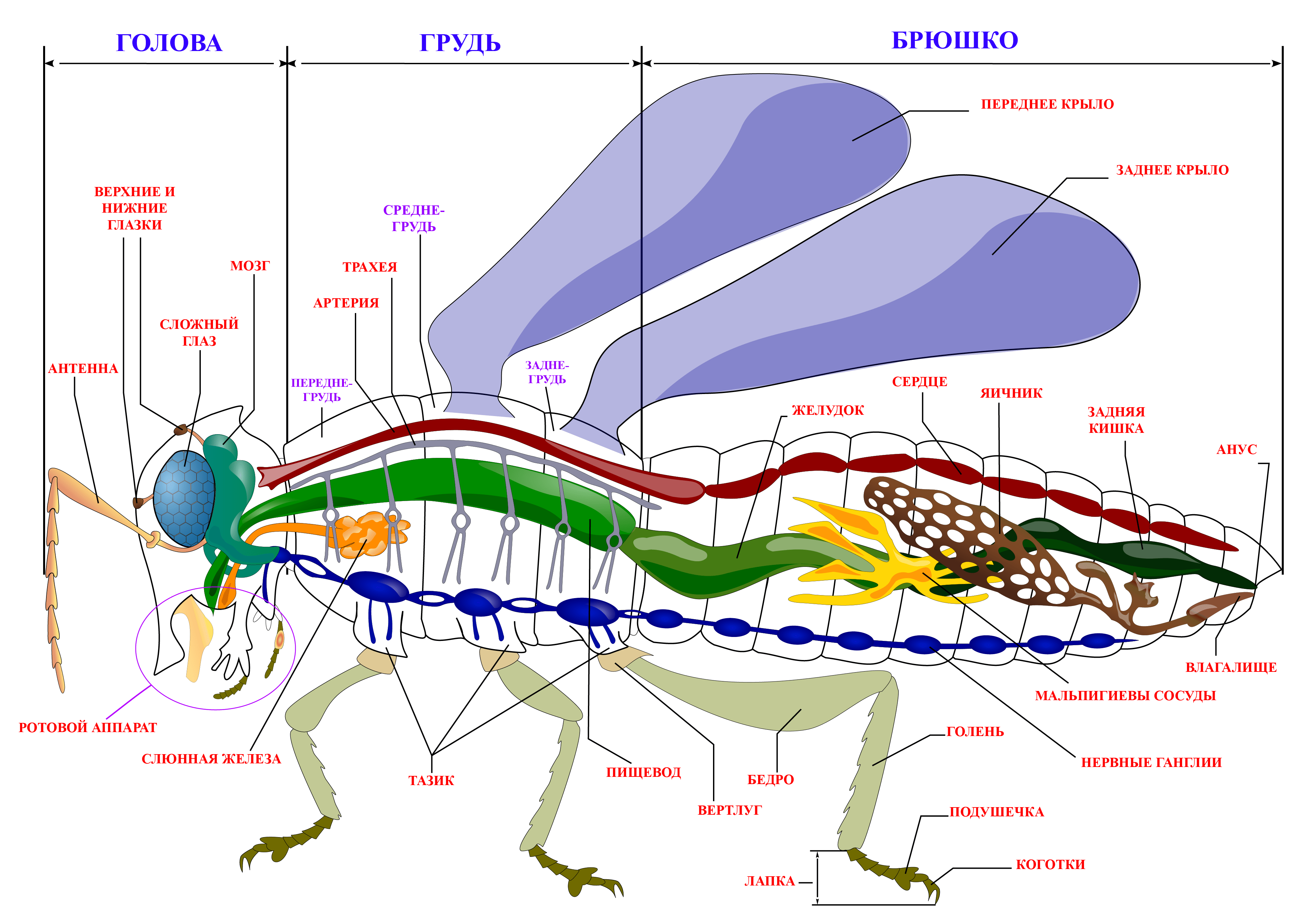How the brain, wing and mouth apparatus of a room fly work: the secrets of a small organism
In appearance, it seems that the fly is the simplest insect with an unpretentious structure. However, this is not at all the case, and the anatomy of the parasite is the subject of research by scientists, while many secrets of its body have not been revealed so far. For example, not everyone knows how many wings a fly actually has.
Content
Distinctive features of houseflies
This subspecies of the parasite is considered the most common and studied. Several external features distinguish the pest from relatives. Distinctive features of homemade tsokotuha:
- Body length varies from 6 to 8 mm.
- The main color of the body is gray, with the exception of the head: it is colored yellow.
- Black stripes are visible on the upper body. On the belly there are spots of a dark shade of the correct quadrangular shape.
- The lower part of the abdomen is slightly yellowish.
The external structure of the fly
The external structure of the flying parasite is typical for similar insect species. The skeleton is represented by the head, abdomen and chest. On the head are the eyes, antennae and mouthparts. The thoracic region is represented by 3 segments; there are transparent wings and 3 pairs of legs. Powerful muscles are located in the space of the thoracic region. Most of the internal organs are located in the abdomen.
fly head
The structure of the head is elementary. It contains the oral apparatus, organs of hearing and vision.
Chest
As mentioned above, the chest consists of 3 segments: anterior, middle and metathorax. On the mesothorax there are muscles and bones involved in flight, so this department is most developed.
Abdomen
The abdomen is cylindrical, slightly elongated. Covered with a thin layer of chitinous cover with high elasticity. Due to this quality, during eating or bearing offspring, it is able to greatly stretch.
The abdomen consists of 10 segments, it houses most of the vital internal organs.
Fly legs and wings
Interestingly, during the flight, the fly is able to turn off one of the wings.
Common fly: the structure of internal organs
The internal structure of the insect is represented by the digestive, reproductive, circulatory system.
Sexual system
The organs of the reproductive system are located in the abdomen. Flies are sexually dimorphic. The female reproductive system consists of eggs, accessory glands and ducts. Different subspecies differ in the structure of the external genital organs. Males have a special kind of grip that allows them to hold the female during mating.
Digestive system
The digestive system of flying pests consists of the following organs:
- goiter;
- malpighian vessels;
- intestines;
- excretory ducts.
All these organs are also located in the abdomen of the insect. At the same time, the digestive system can be called such only conditionally. The body of the fly is not able to digest food, so it comes there already processed. Before swallowing food, the insect processes it with a special secret, after which the latter becomes available for assimilation and enters the goiter.
Other organs and systems
Also in the body of the zokotuha there is a primitive circulatory system, consisting of the following organs:
- a heart;
- aorta;
- dorsal vessel;
- pterygoid muscle.
How much does a fly weigh
Pests are practically weightless, so they are often not felt on the body. An ordinary housefly weighs only 0,10-0,18 grams. Carrion (meat) species are heavier - their weight can reach 2 grams.
How a fly buzzes
As mentioned above, on the body of the fly are located halteres - atrophied second pair of wings. It is thanks to them that the insect makes an unpleasant monotonous sound, which is commonly called buzzing. During flight, the halteres move at the same frequency as the wings, but in the opposite direction. The sound is produced by the passage of air between them and the main pair of wings.
Features of the development and life of the fly
In the course of its life, an insect goes through a full cycle of transformation: egg, larva, pupa and adult. However, there are several varieties that do not lay eggs, but give birth to larvae immediately.
Fly larvae resemble small white worms. At this stage of development, insects still lack internal organs - they are formed when the larva pupates. Maggots do not have legs, and some do not have heads. They move with the help of special processes - pseudopods.
The lifespan of the zokotuh is short - even under ideal conditions, their maximum life expectancy is from 1,5 to 2 months. The life cycle of an insect directly depends on the time of birth, as well as climatic conditions. With the onset of cold weather, the flies try to find a warm shelter for themselves for wintering, but most of them still die, as they become infected with a moldy fungus. Pupae and larvae stop their development in winter and thus survive the cold. In the spring, young individuals appear from them.
In addition, a person has a significant influence on the life expectancy of flies, as he tries to destroy them at all stages of development. It is also known that males live much less than females: they do not need to reproduce offspring, in addition, they are less cautious and tend to choose not very reliable shelters.
